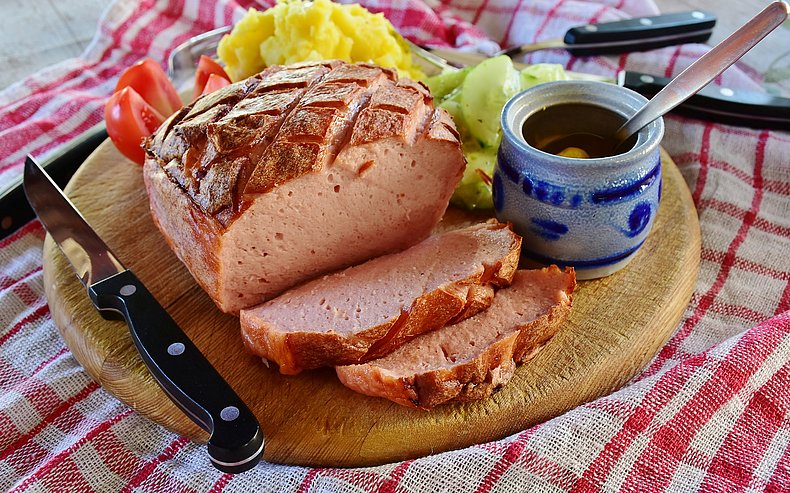German cuisine is often regarded as hearty and meaty. Even if today this no longer fits the everyday diet of most Germans, it does apply to many of the traditional dishes. However, what many people don't know is that lots of German classics have insanely crazy and funny names. That's why we present a new German dish with an unusual name on Facebook every two weeks. Here you can read about where the dishes are typically served and how you can cook them at home.
Recipes of German Dishes with the Weirdest Names
#13 (Schwäbische) Seelen - (Swabian) Souls
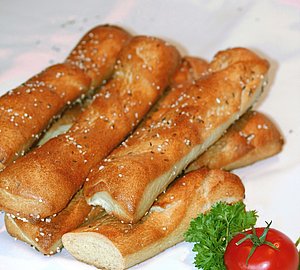
The so-called "soul" is, like the Maultaschen, from Swabia and therefore often called the Swabian soul in the other regions of Germany. It is a long white bread pastry, which is probably somewhere between baguette and bread roll and is typically baked with some caraway seeds. Its unusual name is probably due to the Christian holiday of All Souls' Day, on which the dead are remembered. These so-called "poor souls" were probably served with food sacrifices on this holiday in order to obtain harvest blessings for the coming year. Later on, those in need were given the soul breads and other pastries.
Ingredients (for 8 Seelen):
| Pre-dough: | Main dough: |
| 200g wheat or spelt flour | 800g wheat or spelt flour |
| 220ml water | 480ml water |
| 5g yeast | 30g yeast |
| For sprinkling: | 25g salt |
| some caraway seeds | 3g sugar |
| some coarse sea salt | 20ml milk |
Preparation:
- Mix the ingredients for the pre-dough until smooth and leave to mature at room temperature for 12 to 14 hours.
- Slowly mix the pre-dough with the remaining ingredients of the main dough and knead for about 12 to 15 minutes. Then cover the dough and let it rest at room temperature for about 40 to 45 minutes.
- Open the bowl with the dough, first divide it with wet hands into about 3 pieces and then twist them together with a fast, circular motion around the longitudinal axis. Then cover the dough again and let it stand for another 40 to 45 minutes, work the dough again in the way described above and let it rest for another 5 minutes.
- Then place the dough on a moistened work surface, spray it with water and let it rest again for 20 to 30 minutes.
- Now fold your fingertips of both hands together, keeping the fingers closed so that the hands form a large "U". Place the edges of the hands on the dough from above, press through and pull forward. Place the resulting dough pieces on the baking tray covered with baking paper.
- Preheat the oven to 275° C. Bake the souls at this temperature for about 10 minutes. Then spray with water and sprinkle with sea salt and caraway seeds.
- Now bake the souls at 250° C for another 10 to 20 minutes. Then spray them with some water and let them cool down on a grill.
#12 Baumkuchen - Tree Cake
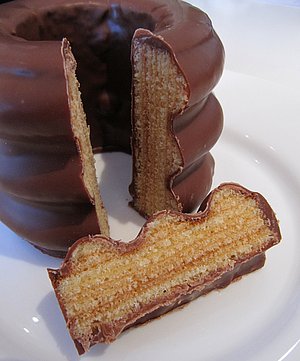
The Baumkuchen is a ancient bakery product and popular since the Middle Ages. Originally from Hungary, it became an important part of German cuisine at an early age and is extremely popular, especially at Christmas time. The cake owes its funny name probably simply to its appearance: the round form with slight notches and the " tree rings " inside the baked goods which are created by its layers. Baumkuchen is actually applied in layers to a stick and baked over an open flame. This is also the reason for its characteristic shape with the round hole in the middle. Since it is hard to do this at home if you don't live in a pastry shop, you will find the recipe for the simpler but nevertheless delicious Baumkuchen cubes, which can also be made in the oven.
Ingredients (for about 60 small cubes):
| 250g butter |
| 220g suagr |
| 2 sachets vanilla sugar |
| 6 eggs |
| 200g flour |
| 50g ground almonds |
| 2 teaspoons baking powder |
| 100ml extra strong coffee |
| 150g currant jam |
| 300g marzipan raw mass |
| 300g chocolate coating, plain |
Preparation:
- Mix butter, sugar and vanilla sugar. Add the eggs one by one, stirring each egg in 2 minutes.
- Mix the flour, starch, almonds and baking powder and stir in together with the coffee.
- Place 4-5 tbsp. dough on a baking tray covered with baking paper and baking frame (approx. 20 x 30 cm), bake under the grill until brown (for approx. 3 minutes). Continue until the dough is used up.
- Let the cake cool, cut the edges clean and spread the jam on the dough.
- Roll out the marzipan between two freezer bags (approx. 20x30cm). Pour the marzipan over the jam.
- Melt 2/3 of the chocolate coating in a water bath, plane the rest.
- Cut the plate of cake into cubes and cover one after the other with the chocolate coating. Then sprinkle with the chocolate coating.
#11 Tote Tante - Dead Aunt

When it gets cold outside and the Christmas markets open their doors, it's time for mulled wine and Tote Tante (also known as Lumumba off the North Sea) in Germany. But don't worry, there is no dead person cooked. It is simply a hot cocoa with a dash of rum and a lush crown of cream. Originally, the drink is said to come from the island of Föhr and owes its name to an aunt who emigrated from Föhr to the USA and died there but wanted to be buried in her homeland. To save costs, the urn with its ashes is said to have been brought back to the island in a cocoa delivery. For all those who don't like rum, it can be easily replaced with amaretto or brandy.
| about 8cl rum |
| 2 tbsp cream |
| cocoa powder for two cups |
| about 800ml milk |
Preparation:
-
Heat milk and mix with cocoa powder to a strong cocoa.
-
Add the rum (amount can be varied according to taste).
-
Whip the cream and add to the cups.
- Drink and warm without stirring.
#10 Arme Ritter - Poor Knights
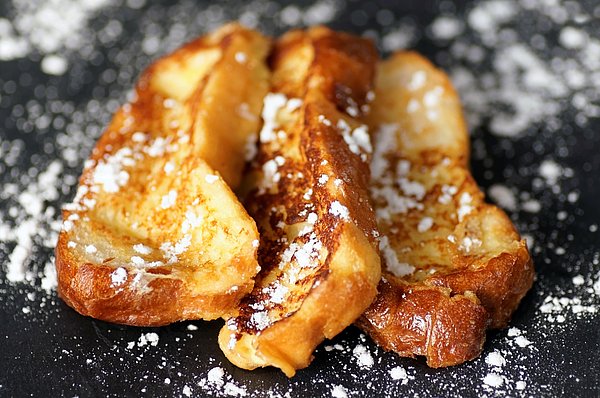
“Arme Ritter” is an ancient dish. Its first recipe can be found in a cookbook from the 14th century. Even the Brothers Grimm, Germany's best-known collectors of fairy tales, mention “Arme Ritter” in their dictionary. The name probably comes quite simply from the fact that the dish is inexpensive and easy to prepare - after all, it is mainly made from leftovers of bread - but still greasy and satiating: Something you can serve the knight who can no longer afford meat. In many other countries “Arme Ritter” is known in slight variations under other names: French toast in the USA and Canada, Pain Perdu in France and so on.
| 300ml milk |
| 2 eggs (size M) |
| 50g sugar |
| 6 slices of white bread, toast or half bread rolls |
| 50g clarified butter |
| On request: compote, sugar powder or cinnamon |
Preparation:
-
-
Mix milk with eggs and sugar.
-
Place the bread in a bowl and pour the egg milk over it. Turn carefully and wait until the milk is absorbed.
-
Heat the clarified butter in a coated pan. Bake the slices in portions at medium heat on both sides for about 8 minutes until crispy brown. Serve hot, if desired with a little cinnamon, sugar powder or fruit compote.
-
#9 Hackepeter - Mince Peter
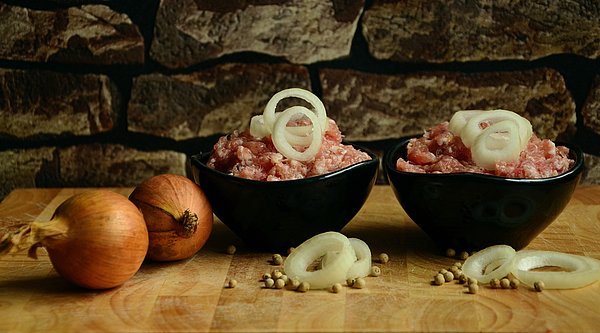
Hackepeter is the name for seasoned raw minced meat that is so fresh that you can eat it raw - basically like a tatar, but not made from beef. Therefore, for hygienic and health reasons, it may only be sold on the day of preparation and should be stored consistently in the refrigerator after purchase and consumed within a day. As a rule one eats Hackepeter as bread or bread roll topping. The dish is called Hackepeter mainly in northern Germany and in Berlin, elsewhere it is also called “Zwiebelmett”. Allegedly, the Hackepeter was first offered under this name in 1903 in a Berlin inn.
| 500g pork / half pork half beef "Mett" (minced meat fresh enough to eat it raw) |
| 6 bread rolls (or slices of bread) |
| 2 onions |
| salt |
| pepper |
| if desired: garlic, caraway |
Preparation:
Peel onions (and if desired garlic) and cut into small pieces. Pour into a bowl with the minced meat.
Mix salt and pepper (as well as caraway if desired) with the meat and knead well.
Place the minced meat on the halves of the bread roll or slices of bread.
#8 Rollmops - Rolled Pug
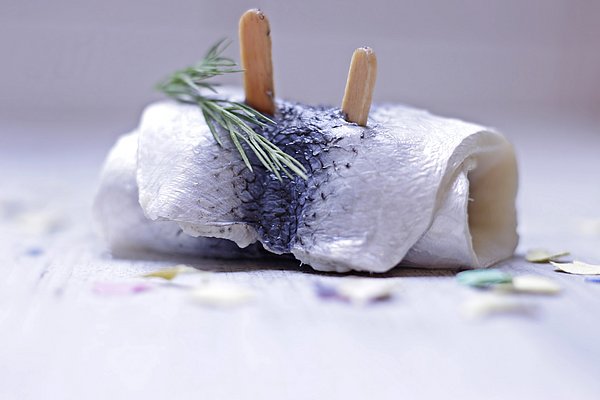
The Rollmops fortunately has nothing to do with the small, sweet dog breed. However, at the time of its creation, some people felt reminded of the pug by the appearance of the rolled up, filled herring - for whatever reason. The stuffed fish originally comes from Berlin, but is widespread throughout Germany nowadays. The fish, which has been preserved longer by pickle, is particularly popular as a snack. It is also considered to be a unique hangover treatment and is therefore not only sold on the Hamburg fish market after a night's drinking on the Reeperbahn, but can also be found on some people's breakfast tables at home after alcoholic nights. This is mainly due to the high salt content of the food, which is also known as Gabelroller (fork roller) in Austria. The herring is classically filled with pickled cucumbers and onions. The rolled up fish is fixed with two wooden sticks, which are used as fork replacements for consumption.
| 4 green (fresh, not pickled) herrings |
| 1 tbsp medium hot mustard |
| 2 gherkins |
| 1 onion |
| 1/2 tbsp capers |
| 1/2 tbsp peppercorns |
| 125 ml water |
| 1/2 Dill bunch |
| 1 bay leaf |
| 2 tbsp vinegar |
| salt |
| some sugar |
| 8 small wooden sticks |
Preparation:
Boil water, vinegar, a little salt, sugar and the bay leaf to a broth. Let it cool completely (!).
Peel the onion and cut into fine slices. Cut the gherkins into quarters or eighths depending on their size. Coarsely chop the capers and peppercorns and mix with the mustard.
Debone the herrings, cut off the head, wash and clean completely. Dab dry lightly with paper towels. Fold the fish parts apart and salt lightly.
Spread the mustard mixture, onions and gherkins over the fish and roll them up like a roulade. Then fix with wooden sticks.
Layer the rolls in a sealable container, such as a glass. Pour over the spice stock so that the rolls are completely covered and close.
Leave to stand in a cool place for 4 to 5 days.
#7 Spaghettieis – Spaghetti Ice
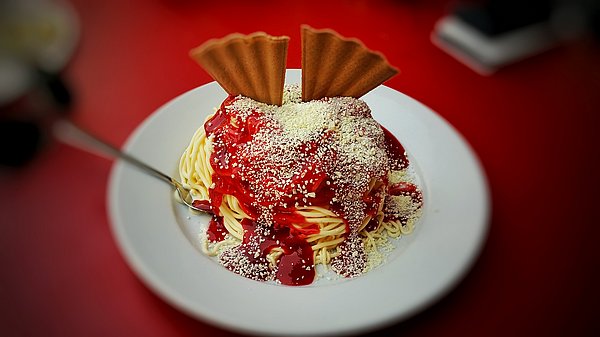
“Spaghettieis” is one of the most popular ice cream sundaes in Germany and can be found in almost every ice cream shop here. The origin of the name is actually quite obvious: The sundae looks like spaghetti with tomato sauce and parmesan - only that the noodles consist of vanilla ice cream, the sauce of strawberries and the cheese of white chocolate. It is not quite clear who first came up with the idea of pressing the ice cream through a spaetzle press so that it ends up in thin threads on the cream. However, one who claims the invention for himself is the Mannheim ice cream store owner Dario Fontanella. According to his own statement, he had already put the creation on his menu in 1969 - but let himself be deterred by the costs and his father from patenting it. Something that the two must have regretted, as the sundae should spread throughout Germany very quickly. Meanwhile there are also many variations of the dessert: with other fruits, other types of ice cream or coconut flakes. To make the original yourself, you mainly need a well-cooled spaghetti, spaetzle or potato press with fine holes.
| 200g strawberries |
| 2 tablespoons sugar |
| 100g whipped cream |
| 12 scoops vanilla ice cream |
| 2 tablespoons White chocolate shavings |
| spätzle or spaghetti press |
Preparation:
Dice the strawberries (except for two or three pieces for decoration), sprinkle with the sugar and leave to infuse for about 30 minutes. Puree finely with a hand blender.
Wash and dry the press well and put it in the freezer for about 15 minutes; otherwise, the ice will melt while you press it through.
Whip the cream until stiff and spread on four plates. The cream must be under the ice to freeze and not disturb the look.
Press three scoops of vanilla ice cream per plate through the press on top of the cream.
Spread the strawberry sauce on the ice cream and sprinkle everything with the chocolate shavings. Then decorate with strawberry slices and enjoy.
#6 Falscher Hase - False Rabbit
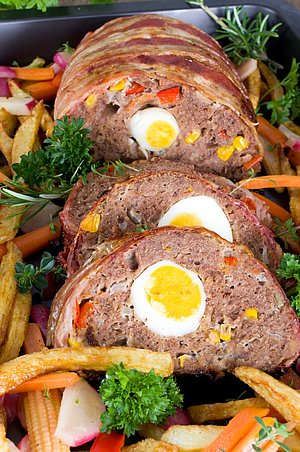
The false rabbit, also called hay bunny, is a meat loaf. It consists of minced meat, onions and boiled eggs. Depending on the recipe, pieces of vegetables are added to the dough or slices of bacon are used as a crust. It is usually served with oven vegetables, potatoes and gravy. The origin of its name is, however, quite controversial, but has probably something to do with the fact that in Germany of the late 19th and early 20th centuries the roast or saddle of hare was one of the most popular Sunday roasts. After all, hare meat was tasty and the high number of offspring of the animals made it easily accessible. Some therefore believe that meat loaf used to be made in so-called hare pans and roasts (special forms that were used in the 19th century for saddle of hare) and are therefore called accordingly. However, the most widespread theory is probably that the name originated after the end of the Second World War. By the time, rabbits were as good as extinct through famines and bombardments and were therefore placed under the protection of species. The meat loaf is said to have served as an affordable substitute.
| 4 eggs (size M) |
| 50g shallots |
| 2 tablespoons butter |
| 500g mixed minced meat (beef and pork) |
| 40g breadcrumbs |
| 3 teaspoons mustard |
| salt |
| pepper |
| transparent film |
Preparation:
Pierce three of the eggs and cook them for about 10 minutes (until hard). In the meantime, finely dice the shallots and fry them in a tablespoon of butter until translucent. Then remove them from the heat. Quench and peel the eggs.
Put the cooled shallots in a bowl with the minced meat, the breadcrumbs, the mustard and the remaining egg. Add salt and pepper to taste. Then carefully knead with the dough hook of a hand mixer.
Press the minced dough with wet hands on transparent film to a flat surface (approx. 25 x 25 cm). Place the hard-boiled eggs in a row in the middle, cover them with minced meat and form everything into a loaf. Melt a tablespoon of butter and spread all over the loaf.
Now place the meat loaf on a greased baking tray and bake at 200 degrees on the middle shelf for approx. 45 minutes in the oven. After taking it out, let it rest for a moment and then cut it into slices. Serve with side dishes such as potatoes and vegetables.
#5 Radler - Cyclist

Don't worry, despite the meaty German cuisine these are not real cyclists! Radler is rather the name for a popular mixed beer drink with lemonade. But be careful: The names of this refreshment vary strongly in the German-speaking area. In northern Germany the cyclist is often called Alster or Alsterwasser (Alsterwater) - following Hamburg’s river’s name Alster, while in the Ruhr area, if you order an Alster, you get a beer with orange lemonade instead of lemonade. In Bavaria it is often served with wheat beer and called "Russe" (Russian). The origin of the name Radler is also controversial: Some believe that the Radler was invented in a bicycle club, others attribute the name to the fact that cyclists who stopped at restaurants did not want to drink too much alcohol and thus the mixed drink developed as an alternative. Still, one thing is certain: especially in summer and after an extensive cycling or hiking tour, such a Radler is an ideal fresh-fruity cool-down!
| 1 bottle of beer |
| lemonade |
Preparation:
Even if it takes a little longer: in order to get a nice foam crown you have to first fill the glasses half full with beer and then let them rest for a moment.
Now hold the glasses at an angle and fill them up with the lemonade. For the perfect foam, add a small amount of beer at the end. The ratio should be 50:50.
#4 Kalter Hund - Cold Dog
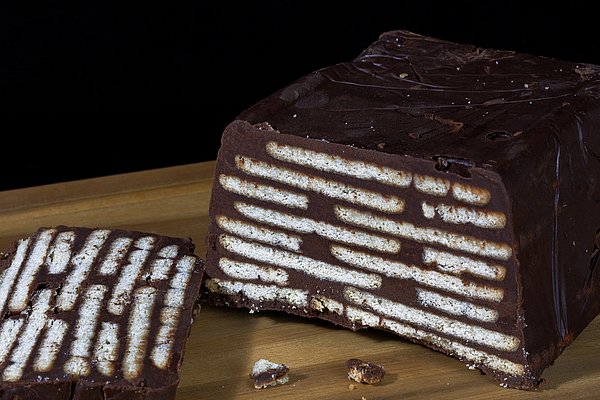
The chocolate biscuit cake “Kalter Hund” presumably exists since the early 20th century. The name probably comes from the fact that the cake is made without baking and the box form of the so-called "Grubenhunt" (pit dog) in the mining industry reminds of the baking form of the cake. Another well-known name for this is “Kalte Schnauze” (could muzzle), which probably comes from the fact that the cake’s surface is supposed to resemble the cold muzzle of a dog. The cake is especially popular at birthday parties and other festivities for children.
| 200g dark chocolate (70% cocoa) |
| 200g whole milk chocolate coating |
| 250g coconut fat |
| 2 eggs (size M) |
| 75g icing sugar |
| 2 tablespoons cocoa powder |
| 5 tablespoons rum (if appropriate) |
| 200g butter biscuits |
| cling film |
Preparation:
Chop the chocolate and the couverture.
Melt the coconut fat and the chopped chocolate and chocolate coating in a hot water bath.
Whisk the eggs, icing sugar, cocoa and if you like the rum with a manual mixer until foamy. Then stir the melted chocolate in well and put the mixture back into the water bath.
Lay out a box mould (approx. 1.5 l content) with cling film. Spread some chocolate cream on the bottom of the mould. Place 4 to 5 butter biscuits side by side in the mould on top of the cream. Repeat the layering process until the biscuits and cream are used up and finish with a layer of biscuits. Then cool the cake in the refrigerator for at least 6 to 8 hours and let it set.
Take the cake out of the fridge, turn it down and remove the cling film. Sprinkle the cake with cocoa powder as you like and serve.
#3 Strammer Max - Strapping Max
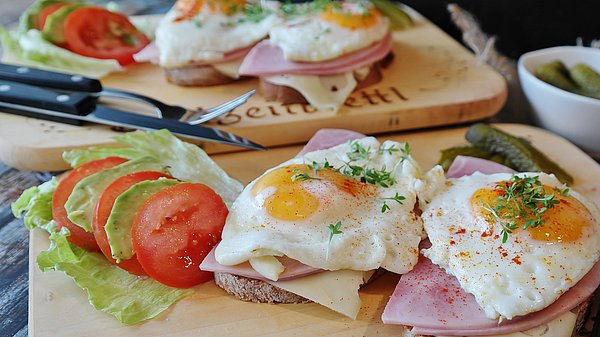
The "Strammer Max" is an expression from the Saxon language, which probably exists since the 1920s and actually means an erect penis - even today, for example, one still uses the word "Pipimax" (pee Max) for penis when talking to very young children. The transfer of the term to the bread covered with fried eggs and ham probably either comes from the fact that it is a particularly hearty dish or because one has at times expected an increase in sexual abilities from eating it. Just like its name, the recipe originally comes from the region around Saxony and Berlin but is popular throughout whole Germany as a home-style fare and pub snack nowadays. There are different variations like “Stramme Lotte”, “Strammer Moritz” or “Strammer Otto”, which differ slightly in the ingredients. Important for the dish is the German farmer's or grey bread, which sadly is difficult to find abroad outside German bakeries. If you want to bake the bread yourself, you will find a recipe here.
| (approx. 6 tablespoons) butter |
| 8 eggs (size M) |
| 4 slices of farmer's or grey bread |
| 4 slices of ham |
| salt |
| pepper |
| on request: pickled gherkins, cheese (Gouda or Emmenthal |
Preparation
Heat some butter in one pan (or two because of the amount of eggs). Beat the eggs one after the other and let them slide carefully into the pan, then fry them over medium heat until they become fried eggs and season to taste with salt and pepper.
Some also toast or roast the bread slices. Traditionally, however, they are simply spread with butter and then covered with ham. It is also optional to place a slice of cheese on the ham.
Arrange two eggs on each slice of bread.
Serve as desired with or without gherkins.
#2 Leberkäse – Liver Cheese
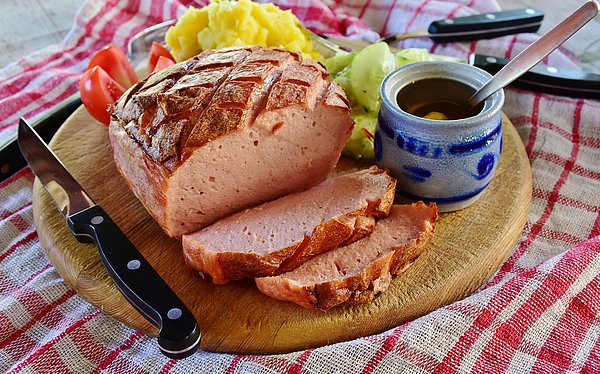
Leberkäse, also called Fleischkäse or Fleischlaib, is a kind of boiled sausage and is widespread in Germany as well as in Austria and Switzerland. In the past (at least outside Bavaria) liver actually belonged in the sausage. The term cheese derives from the characteristic loaf shape, an angular pate shape. Nowadays, liver is very rarely found in this loaf of meat. Leberkäse is particularly widespread as a topping for bread rolls with a little mustard. Slices of Leberkäse are sometimes fried separately and served with vegetables and potatoes. In addition, the Fleischkäse is used in various pan and casserole recipes. Leberkäse can be bought ready-made in most (German) supermarkets and at many fast-food stalls in bread rolls. You can find the recipe here, but you need at least a good food processor for it.
| 600g lean pork meat |
| 400g pork belly meat |
| 25g curing salt |
| 4g White ground pepper |
| 1 pinch of majoram |
| 1 pinch of thyme |
| 1 pinch of nutmeg |
| 1 pinch of ginger |
| 300g ice snow* |
| 1 tablespoon coconut fat (or similar) |
*Ice snow can be made with a cutter or a food processor, or by putting ice cubes in a plastic bag wrapped in a cloth and then working with a hammer and rolling pin until a flat mass of small ice crystals remains.
Preparation:
Cut the meat into small pieces and place in the fridge for about 30 minutes. When it is just before freezing, remove and mix well with the spices. Cool a square pâté dish.
Chop the meat in the food processor as small as possible for one to two minutes with a very fast rotation.
Now add the ice snow and chop everything up again until a fine, viscous mass is formed, which should then be processed quickly.
Grease the well-cooled mould thoroughly, add the mixture and make sure that no air bubbles form. Then smooth with a dough scraper and carefully press in a light diamond pattern.
Preheat the oven to approx. 160°C at top/bottom heat and then bake for approx. 90 minutes.
#1 Maultaschen – Mouth Bags
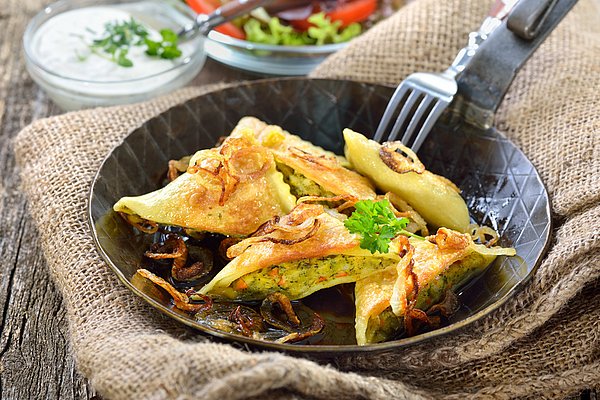
Maultaschen are not bags from mouths, but from pasta dough. They are filled with sausage meat, onions and soaked bread rolls. There is also a vegetarian version with cheese and spinach. Traditionally, they are either served as a soup insert in broth, "geschmälzt", so poured with onions fried in butter or cut into strips and then fried with onions. The dish comes from the Swabian region, which lies in southern Germany between Baden-Württemberg and Bavaria.
| Doug: | Filling: |
|---|---|
| 2 eggs | 2 bread rolls |
| 200g flour | 100ml whipped cream |
| 30g durum wheat semolina | 400g onions |
| salt | 1 tablespoon butter |
| 1 bunch smooth parsley | |
| salt, pepper | |
| sugar | |
| 300g mixed minced meat | |
| 200g sausage meat | |
| 2 tablespoons breadcrumbs | |
| 3 eggs | |
| nutmeg | |
| 1 teaspoon marjoram | |
| (1l strong beef stock) |
Preparation:
For the dough, whisk the eggs with three to four tablespoons of water and mix them with flour, semolina and a little salt to a smooth and firm dough. Then knead the dough vigorously on a work surface sprinkled with flour for one minute and let it rest for 30 minutes.
Cut the bread rolls into thin slices and put them in a bowl. Heat the cream and pour it over the bread rolls. Then finely dice the onions. Melt the butter in a frying pan and fry the onions until translucent. Wash the parsley, chop finely, add to the onions and steam for three to four minutes. Finally add salt, pepper and a pinch of sugar and let cool.
Now put the minced meat, the sausage meat, the bread rolls, breadcrumbs, eggs and onion mixture in a bowl and agitate it to an even mass. Flavor with salt, pepper, nutmeg and marjoram and then cool it covered.
Now divide the dough into three portions. Roll out one portion on the floured work surface about 2 mm thin to about 42x32 cm and place it on a kitchen towel. Then smooth out 1/3 of the filling on the dough and roll up the dough loosely from the long side using the kitchen towel. Use a wooden spoon handle to divide the roll into four equal pieces and press the dough firmly into place. Cut off the pieces with a knife and work up the rest of the dough and filling in the same way. It is no problem if the dough does not completely enclose the filling.
Pour the Maultaschen into plenty of boiling salted water, reduce the heat and leave them in it for 10 minutes, but do not let them boil. Let them drain afterwards.
Heat beef stock and serve Maultaschen in it or - as described above - process as desired.



